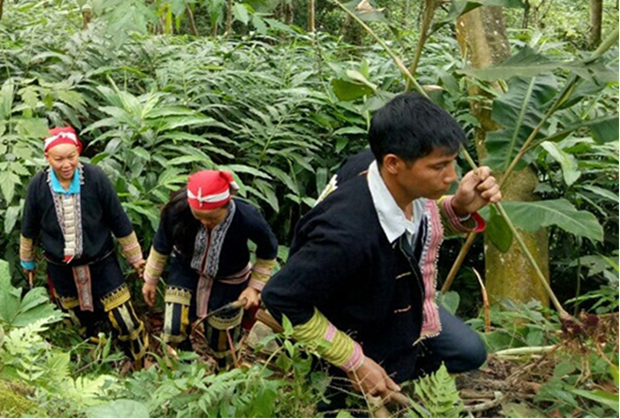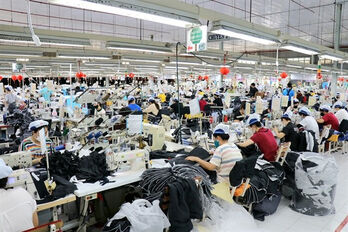 Chảo Cói Mẩy (first, left) of Sai Duan Village, Phin Ngan commune, Bat Xat district goes to the forest to look for medicinal plants. (Photo: batxat.laocai.gov.vn)
Chảo Cói Mẩy (first, left) of Sai Duan Village, Phin Ngan commune, Bat Xat district goes to the forest to look for medicinal plants. (Photo: batxat.laocai.gov.vn)
Lao Cai province currently has 30 craft villages, of those 20, such as brocade weaving, embroidery, silver carving, incense making, bamboo and rattan see a majority of female managers and workers.
The success of female leadership is proven in models like the sewing and brocade embroidery villages in Ngai Tro village (Y Ty commune, Bat Xat district); brocade sewing and embroidery village in Ni Xi Village (Pha Long commune, Muong Khuong district); brocade weaving village of Tay people (Nghia Do commune, Bao Yen district); brocade weaving village of Giay people (Ta Van commune, Sa Pa town); and the weaving village of Thu Lao people (Ta Gia Khau commune, Muong Khuong district).
For the Dao Ho ethnic group in the province, clothes made from self-woven fabrics play an important role in their daily lives, especially in special rituals.
Dao Ho women in Tra Trau village, Son Ha commune, Bao Thang district, have long kept the traditional way of weaving for generations. Almost every household in the village has a loom.
A local resident Trieu Thi Ha, 60 years old, said that she learned how to weave when she was a child.
Previously, the Dao people in Tra Trau grew cotton and weaved cloth by themselves, she said.
Now they could easily buy cotton at the market to make clothes.
“Cotton bought at the market still has to be processed through many stages,” she said.
After spinning, handfuls of yarn are put into a pot of boiling water and boiled for six hours.
A large pot of porridge with plain rice is poured into the yarn, then the material is rubbed. The yarn is then dried in the sun so that it does not break when spinning.
After weaving and dyeing indigo, the cloth is cut and sewn. Finally, Dao women meticulously embroider and create accents for the outfit.
Head of the Culture and Information Department of Bao Thang district Le Hai Thanh said that after the weaving profession of the Dao Ho people in the district was recognised as a national intangible cultural heritage, the locality actively promoted it.
They opened classes to teach young people about the traditional weaving craft, he said.
In Sai Duan village, Phin Ngan commune, Bat Xat district, a local woman named Chao Coi May called on doctors to join her team which provides bathing herbs and homestays for tourists.
May said that she followed her mother to the forest to find medicinal leaves when she was a child.
She was taught about traditional medicine and mastered dozens of traditional herbal remedies of the Red Dao ethnic group.
“I have been looking for and recording remedies and passed them on to my grandchildren,” she said, adding that she always told people to keep forests, so that they could preserve medicinal plants and earn from the plants.
May’s initiative has attracted and created jobs for fifteen women in the village with stable incomes. The introduction of baths with medicinal plants has developed the potential of using herbal medicine of the Red Dao people in Sai Duan village.
Meanwhile, Lu Thi Tuoi, a 32-year-old woman from the Tay ethnic group in Bac Ha district, chose to start her business with green rice flakes – a dish that was only available during the holidays to celebrate the new rice of the Tay people in Na Lo village, Ta Chai commune.
Bac Ha green rice flakes are made from local glutinous rice varieties grown in the cold climate.
Thanks to a longer growing period, the flakes are soft and have a special taste compared to those in other localities. The product is enjoyed by visitors.
Tuoi said she started the business in 2020.
With her family's experience in the traditional profession, she always uses the best rice varieties so that the green rice flakes are sticky and fragrant.
Realising the increasing demand of consumers for products with clear origin and food safety, before last year’s crop, Tuoi completed procedures for her product to be recognised as satisfying hygiene and safety standards, with clear packaging, labels, and QR codes.
Accessing social networks such as Facebook or Zalo, Tuoi usually got stable output for her products, she said, adding that she sometimes sold out of products for consumers in Hanoi, Lao Cai city or Phu Tho province.
As the market is expanding, Tuoi gradually established a co-operation group and built a brand for Na Lo – Bac Ha green rice flakes.
Tuoi said that the consumption this year was good, with the price of the green rice ranging from 140,000 – 150,000 VND per kilo.
Her co-operative group had sold nearly ten tonnes of green rice, earning an average income of 15-25 million VND per household per crop./.
VNA
 Ministry proposes centralised platform for electronic labour contracts
Ministry proposes centralised platform for electronic labour contracts

 Chảo Cói Mẩy (first, left) of Sai Duan Village, Phin Ngan commune, Bat Xat district goes to the forest to look for medicinal plants. (Photo: batxat.laocai.gov.vn)
Chảo Cói Mẩy (first, left) of Sai Duan Village, Phin Ngan commune, Bat Xat district goes to the forest to look for medicinal plants. (Photo: batxat.laocai.gov.vn)
